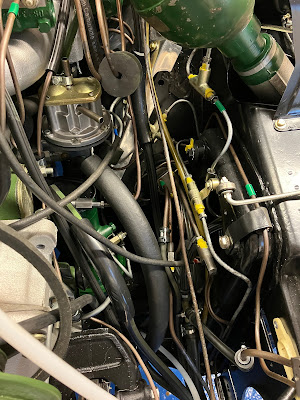Now this really was a BIG milestone. The engine is back in the chassis!
I've been building up to this since the day the engine was taken OUT of the chassis! Way
back then, my friend Richard - a fellow DS owner/ driver - had talked
me into pulling the engine out and had been around to help on the day
in question. Probably to make sure I didn't back out.
 |
| June 2015....... |
 |
| .....and a very recently removed engine. |
On the big day, I tied all the stray hoses and hydraulic pipes in the engine bay out of the way and similarly bundled up all the hoses and belts haning off the engine. I mentally 'walked' through the refit job for the umpteenth time.
 |
| Patiently waiting for an engine |
I
have seen engines put in from the side and from an angle at the front. I
planned to put my engine in from the front. Being a 1968 car, the front
cross member - the one that the horns fix to, and that the craking
handle is stored on - can be unbolted. Which gives improved access for
the reach of the crane. Leaving the car on axle stands instead of front wheels also
meant that it was more stable and a little easier to manouevre the engine
stand without the wheels getting in the way.
I'd
even remembered to adjust the links of the chain holding the hook on
the jib so that the hook naturally sat in the right alignment to the
engine hook on the car's water pump body, and did not try to twist the
engine as we dropped it in. The engine was wheeled in front of the car and the crane attached.
That's
when I remembered I needed to check the height of the rear engine
mounts! This has to be done with the engine weight on them (so before I
lifted the engine with a crane). I'd already made a template for
checking the heights and dug it out.
As my template helpfully reminds me, the procedure for setting the engine mount height is at Operation DX.133-0. That can be found in manual 518. However you can also find the instructions in volume 1 of manual 814. I used cardboard simply because it was easier to cut.
 | |
|
Because of the design of my wooden engine stand, the engine had not been resting on it's front engine mount - it had been propped under the gearbox. Using the crane and a lifting strap, the gearbox was lifted by its cross beam. The tool was applied and the top nut and lock nut adjusted to give the desired heights. Like this.
 |
| Using the tool to check and set the engine mount height |
 |
| 'Make or break' time - quite literally.... |
Slowly and nervously the engine was introduced to the car: "hello engine.....". "Hello car.....". I took a few photos but manouvering the engine and raising it/ lowering at the same time took both our efforts.
 |
| I just KNEW Richard would be pleased to help..... |
I man-handled the engine in to place while Richard lowered the crane arm inch by inch. Worried
that my engine crane would suddenly fail, I was keen to get this over
and done with as soon as possible, but several times we had to raise the
engine and respoistion it before moving it into place again. I was surprised at just how little spare room there was around the engine: there was a matter of millimeters to spare between the engine and the gear brain.
 |
| How does it all manage to fit! |
With some nervousness the pressure in the engine crane was reduced just enough to lower engine an inch at a time and - suddenly - it was in. We
lifted the weight of the engine again and made a micro-adjustment to
line up the number four spark plug hole and bolt holes for the engine mounts. With
great relief we moved the crane out of the way and bolted the engine
down.
The rear engine mounts needed several wobble extensions on the ratchet to navigate the necessary angles to bolt them in place. We tried to fit the drive shafts to the gearbox output housings but found that we couldn't reach the expected torque setting on about half of the twelve bolts. It was clear that threads were being stripped somewhere. Removing one of the bolts we found a delicate curl of sharp steel.
 |
| The thread from a stripped nut! (and a bag of replacements) |
The kettle went on for a celebratory tea and we spent our time admiring Richard's car and making under-bonnet comparisons.
If I'm honest, and after many years of wondering about what this day would be like, my thoughts were never far from the milestone we had just achieved with my car and the next phase of jobs it now enabled, and I imagined my car being parked up on the drive way in the not too distant future.











No comments:
Post a Comment